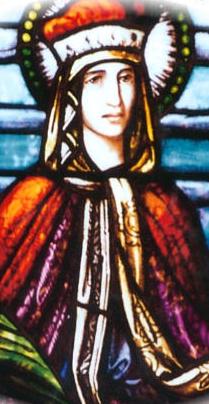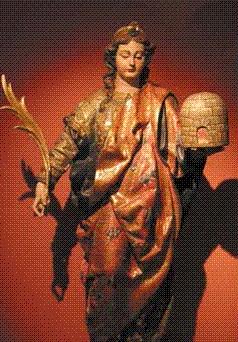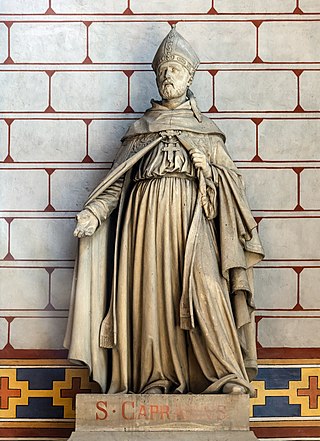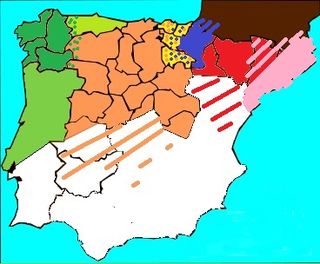
Lucia of Syracuse (283–304), also called Saint Lucia better known as Saint Lucy, was a Roman Christian martyr who died during the Diocletianic Persecution. She is venerated as a saint in the Catholic, Anglican, Lutheran, and Eastern Orthodox churches. She is one of eight women explicitly commemorated by Catholics in the Canon of the Mass. Her traditional feast day, known in Europe as Saint Lucy's Day, is observed by Western Christians on 13 December. Lucia of Syracuse was honored in the Middle Ages and remained a well-known saint in early modern England. She is one of the best known virgin martyrs, along with Agatha of Sicily, Agnes of Rome, Cecilia of Rome and Catherine of Alexandria.

Ursula is a legendary Romano-British Christian saint. Her feast day in the pre-1970 Calendarium Romanum Generale is 21 October. There is little information about her and the anonymous group of holy virgins who accompanied and, on an uncertain date, were killed along with her at Cologne. They remain in the Roman Martyrology, although their commemoration does not appear in the simplified General Roman Calendar of the 1970 Missale Romanum.

Vincent of Saragossa, the Protomartyr of Spain, was a deacon of the Church of Saragossa. He is the patron saint of Lisbon and Valencia. His feast day is 22 January in the Catholic Church and Anglican Communion and the Orthodox Church, with an additional commemoration on 11 November in the Orthodox Church. He was born at Huesca and martyred under the Emperor Diocletian around the year 304.

Ludmila of Bohemia is a Czech saint and martyr venerated by the Orthodox and the Roman Catholics. She was born in Mělník as the daughter of the Sorbian prince Slavibor. Saint Ludmila was the grandmother of Saint Wenceslaus, who is widely referred to as Good King Wenceslaus. Saint Ludmila was canonized shortly after her death. As part of the process of canonization, in 925, Wenceslaus moved her remains to St. George's Basilica, Prague.

June 24 - Eastern Orthodox Church calendar - June 26

Eulalia of Mérida was a young Roman Christian martyred in Augusta Emerita, the capital of Lusitania, during the Persecution of Christians under Diocletian. Other views place her death at the time of Trajan Decius. There is debate whether Saint Eulalia of Barcelona, whose story is similar, is the same person. Up till the proclamation of James, son of Zebedee, Eulalia was invoked as the protector of Christian troops in the Reconquista and was patron of the territories of Spain during their formation.
The Aragonese Way is a route of the Way of St. James beginning at the French-Spanish border at the pass of Somport and joining the French Way at Puente la Reina-Gares in Navarre. It is the continuation of the Arles Way which begins in Arles and crosses the Pyrenees into Spain at Somport.

Susanna of Rome was a Christian martyr of the Diocletianic Persecution. Her existing hagiography, written between about 450 and 500 AD, is of no historical value and the relations it attributes to Susanna are entirely fictitious. It is probable that a real martyr named Susanna lies behind the literary invention.

A cephalophore is a saint who is generally depicted carrying their own severed head. In Christian art, this was usually meant to signify that the subject in question had been martyred by beheading. Depicting the requisite halo in this circumstance offers a unique challenge for the artist: some put the halo where the head used to be, others have the saint carrying the halo along with the head, and some split the difference. Associated legends often tell of the saint standing and carrying their own head after the beheading.

Saint Cucuphas is a martyr of Spain. His feast day is 25 July but in some areas it is celebrated on 27 July to avoid conflict with the important feast day of Santiago, the patron saint of Spain. His name is said to be of Phoenician origin with the meaning of "he who jokes, he who likes to joke."

Saint Marina of Aguas Santas (Marina of Ourense) (c.120–135 AD) is a virgin martyr from Aguas Santas, in the province of Ourense. The story of her life as it has been preserved is a mixture of fact and legends.

Saint Honorina was a 3rd-century virgin martyr of Gallo-Roman northern France, venerated as a saint in the Catholic and Eastern Orthodox Churches. Believed to have been killed in the first years of the 4th century during the persecutions of Diocletian, very little is known of her life, apart from her reputed martyrdom for maintaining her Christian faith.

Severus of Barcelona is venerated as a saint by the Catholic and Eastern Orthodox churches. His legend states that he was a bishop of Barcelona and was martyred during the persecution of Christians by Diocletian in AD 304. Details concerning his life and death are uncertain and of questionable historicity.

Saint Caprasius of Agen is venerated as a Christian martyr and saint of the fourth century. Relics associated with him were discovered at Agen in the fifth century. Local legends dating from the 14th century make him the first bishop of Agen, though, as Alban Butler writes, the only evidence to support his existence is the dedication of a church to him in the 6th century.

Valerie of Limoges is a legendary Christian martyr and cephalophore, associated with the Roman period, whose cult was very important in Limousin, France, in the medieval period. She has been an important subject for Christian art since the middle ages and for porcelain figurines over several centuries.
Saint Indaletius is venerated as the patron saint of Almería, Spain. Tradition makes him a Christian missionary of the 1st century, during the Apostolic Age. He evangelized the town of Urci, near the present-day city of Almería, and became its first bishop. He may have been martyred at Urci.
Saints Peter, Andrew, Paul, and Denise are venerated as martyrs by the Eastern Orthodox and Catholic Churches. They were killed in the 3rd century at Lampsacus, Mysia on the Hellespont.

The Abbey of Santa Engracia was a monastery in Zaragoza, Aragon, Spain, established to house the relics of Saint Engratia and the many martyrs of Saragossa. The date of 392 was traditionally claimed as a foundation date, which was linked with the travels of Saint Paulinus. The church was believed to have been sited on the spot of the martyrdom of Engratia.

Spanish Romanesque designates the Romanesque art developed in the Hispanic-Christian kingdoms of the Iberian Peninsula in the 11th and 12th centuries. Its stylistic features are essentially common to the European Romanesque although it developed particular characteristics in the different regions of the peninsula. There is no Romanesque art in the southern half of the peninsula because it remained under Muslim rule (Al-Andalus). The examples of Romanesque buildings in the central area of the peninsula are sparse and of the latest period, with virtually no presence south of the Ebro and the Tagus. Most Romanesque buildings can be found in the northern third of the peninsula. Romanesque art was introduced into the peninsula from east to west, so scholars have usually defined regional characteristics accordingly: the "eastern kingdoms" comprising the Pyrenean areas, Catalan Romanesque, Aragonese Romanesque and Navarrese Romanesque, and the "western kingdoms" comprising Castilian-Leonese Romanesque, Asturian Romanesque, Galician Romanesque and Portuguese Romanesque.
Guirandana de Lay, was a Spanish healer. She was accused of leading a coven of witches near Villanúa, Spain. De Lay considered herself a healer but was accused of poisoning children and spouses, among other evils, and sentenced to burn at the stake by a seven-man court in Jaca, Spain.
















